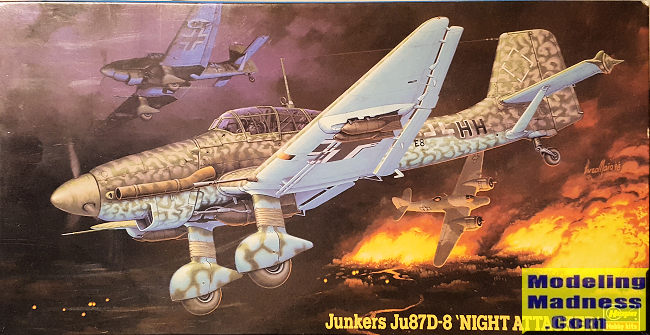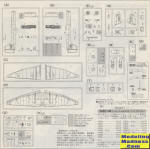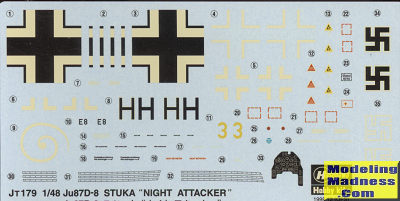
| KIT #: | 09279 (Jt79) |
| PRICE: | $39.95 when new |
| DECALS: | Two options |
| REVIEWER: | Scott Van Aken |
| NOTES: | 1998 limited edition |

| HISTORY |
The Ju 87 had been used in the night intruder role in 1940 and 1941 during The Blitz, but the Soviet Air Force practice of harassing German ground forces using antiquated Polikarpov Po-2 and R-5 biplanes at night to drop flares and fragmentation bombs, inspired the Luftwaffe to form its own Störkampfstaffeln (harassment squadrons). On 23 July 1942, Junkers offered the Ju 87 B-2, R-2 and R-4s with Flammenvernichter ("flame eliminators"). On 10 November 1943, the RLM GL/C-E2 Division finally authorised the design in directive No. 1117.
The need to equip night units and the phasing out of Ju 87s from ground attack groups in favour of the Fw 190, enabled the use of D-5 airframes awaiting repair and D-7 and 8s already in conversion units. The latter variants were either conversions or modified D-1 and D-3 air frames. Adding the necessary equipment, radios and dampeners was a requirement regardless of whether the aircraft was a production D-5 or a D-1 or 3 that had undergone wing changes. The change in designations due to conversions was not readily apparent, for with wing changes, the serial number and designation was applied to the fuselage by the manufacture which remained unaltered by wing changes. Some sub-contractors added an "N" designation (Nacht) for clarity on D-3 and 5s . Others added the roman numeral VII to the D-7s, perhaps to reflect that the aircraft was fitted with the FuG 7 radio. A great deal of confusion exists concerning the D-7. Its existence has been questioned, but the type is listed in Junkers company records and in the Der Reichminister der Luftfahrt and Oberbefehlshabere der Luftwaffe Technisches Amt. There was no production "nacht stuka", and modifications could vary according to the sub-contractor and depending on what parts were available.
A Stuka repair centre was set up at Wels-Lichtenegg. From May 1940 to November 1944, 746 were repaired and flight-tested there. In the winter 1943/44, the Metal Works Lower Saxony Brinckmann und Mergell company (Menibum) converted approximately 300 Ju 87D-3 and 5s to night versions. Dive-brakes were removed there, while gun muzzles and dampers were to eliminate exhaust and muzzle flash. The Jumo 211P engine was installed in some cases. It took 2,170 technicians and workers to carry out the conversions. Total figures for conversions to night flying operations are unknown. The company's equipment was seized by the Soviet Union at the end of the war, and the records were lost or destroyed. A main piece of equipment, hereto not installed in the Ju 87, was the FuG 101 Electronic Radio Altimeter. This was used to measure height. Some Ju 87s also used FuG 16Z transmitter/receiver set to augment the FuG 25 IFF (Identification Friend or Foe).
Pilots were also asked to complete the new "Blind Flying Certificate 3", which was especially introduced for this new type of operation. Pilots were trained at night, over unfamiliar terrain, and forced to rely on their instruments for direction. The Ju 87's standard Revi C12D gunsight was replaced with the new Nachtrevi ("Nightrevi") C12N. On some Ju 87s, the Revi 16D was exchanged for the Nachtrevi 16D. To help the pilot see his instrument panel, a violet light was installed.
On 15 November 1942, the Auxiliary Staffel was created. By mid-1943, Luftflotte 1 was given four Staffeln while Luftflotte 4 and Luftwaffe Kommando Ost (Luftwaffe Command East) were given six and two respectively. In the first half of 1943, 12 Nachtschlachtgruppen ("night battle groups"—NSGr) had been formed, flying a multitude of different types of aircraft, including the Ju 87, which proved itself ideally suited to the low-level slow flying needed. NSGr 1 and 2 fought with some success on the Western Front during the Battle of Normandy and Battle of the Bulge. NSGr 7 operated in "anti-partisan" role from bases in Albania from July 1944, replacing their use of German trainers. The 3rd and 4th group served on the Eastern Front, the 8th in the Arctic and the 9th in Italy. NSGr 20 fought against the Western Allied invasion of Germany in 1945. Photographic evidence exists of 16 NSGr 20 Ju 87s lining up to take-off in the woods circling the Lippe airfield, Germany while under attack from P-47 Thunderbolts of the IX Tactical Air Command. The unit operated against the Ludendorff Bridge during the Battle of Remagen.
| THE KIT |
 This
is one of Hasegawa's limited boxings and what makes it limited is the inclusion
of cast metal parts peculiar to the night attack version. Specifically, you are
provided the long gun barrels, flame damper exhaust, new radio mast and a DF
loop. The exhaust will need to be drilled out to be more convincing.
This
is one of Hasegawa's limited boxings and what makes it limited is the inclusion
of cast metal parts peculiar to the night attack version. Specifically, you are
provided the long gun barrels, flame damper exhaust, new radio mast and a DF
loop. The exhaust will need to be drilled out to be more convincing.
The rest of the kit is standard long wing D model. It has
an acceptable interior with decals available for the instrument panel. Thanks to
the large greenhouse, rounding up some seat harnesses would be helpful. As the
kit is modular, you have a separate engine for the later versions. When building
up the wings, it is important not to forget to drill out holes for the dive
brakes and the outer wing bomb racks. It is fortunate that Hasegawa has chosen
to mold the ailerons/flaps with the lower wing section as that makes
construction so much easier. The rest is pretty standard stuff and based on a
Ju-87B I built several years ago, this one should go together with minimal fuss.

Instructions are well done and provide detail drawings were necessary. You also need to do a bit of minor trimming as well as the usual hole opening so pay attention to those areas. Decals are old school and provide markings for two options. Both start out as standard RLM 70/71/65 splinter camouflage but are painted over fairly heavily. The box art plane has an overspray of RLM 02 and is from NSGr 9. The other has a more open overspray of RLM 65. Both will be fun to paint.
| CONCLUSIONS |
A build-up of this kit is available in the archives and it makes for a super looking model. One thing I would invest in would be a set of canopy masks in addition to the aforementioned seat harness.
| REFERENCES |
https://en.wikipedia.org/wiki/Junkers_Ju_87#Night-harassment_variants
November 2020 Copyright ModelingMadness.com. All rights
reserved. If you would like your product reviewed fairly and fairly quickly, please
contact
the editor or see other details in the
Note to
Contributors. Back to the Main Page
Back to the Review
Index Page
Back to the Previews Index Page